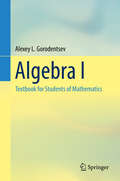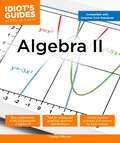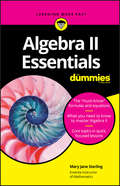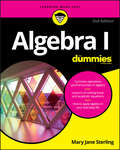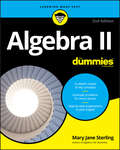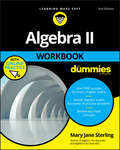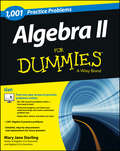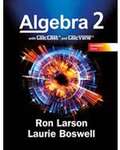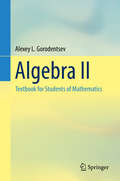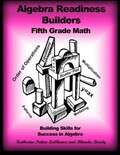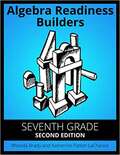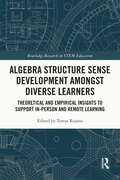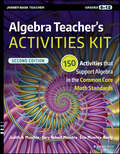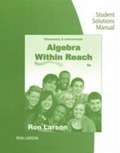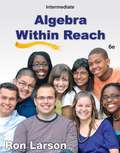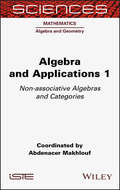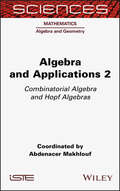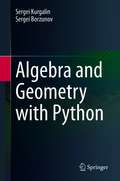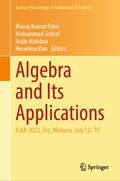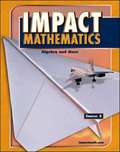- Table View
- List View
Algebra I: Textbook for Students of Mathematics
by Alexey L. GorodentsevThis book is the first volume of an intensive "Russian-style" two-year graduate course in abstract algebra, and introduces readers to the basic algebraic structures - fields, rings, modules, algebras, groups, and categories - and explains the main principles of and methods for working with them. The course covers substantial areas of advanced combinatorics, geometry, linear and multilinear algebra, representation theory, category theory, commutative algebra, Galois theory, and algebraic geometry - topics that are often overlooked in standard undergraduate courses. This textbook is based on courses the author has conducted at the Independent University of Moscow and at the Faculty of Mathematics in the Higher School of Economics. The main content is complemented by a wealth of exercises for class discussion, some of which include comments and hints, as well as problems for independent study.
Algebra II (Idiot's Guides)
by Carolyn WheaterPerhaps no subject strikes so much fear in the hearts of high school and college students as Algebra I, except of course its older, meaner sibling, Algebra II! Starting with reinforcing concepts from Algebra I and with lots of practice and tips along the way, Idiot's Guides: Algebra II eases you into second-year algebra to help you master your academic goals. With Common Core instruction in mind, students get: • A natural transition from Algebra I , with a review of relevant concepts and operations. • An in-depth review and expansion of polynomials. • Easy guidance on solving complex rational expressions and radical functions. • Instructions on how to perform operations on polynomials and factoring. • An exploration of exponential and logarithmic functions. • Tips on solving matrices and determinants. • Special sidebars pointing out the reasoning behind the techniques, which is an essential part of Common Core instruction. • Separate workbook section of extra Algebra practice problems — like getting two books in one.
Algebra II Essentials For Dummies
by Mary Jane SterlingAlgebra II Essentials For Dummies (9781119590873) was previously published as Algebra II Essentials For Dummies (9780470618400). While this version features a new Dummies cover and design, the content is the same as the prior release and should not be considered a new or updated product. Passing grades in two years of algebra courses are required for high school graduation. Algebra II Essentials For Dummies covers key ideas from typical second-year Algebra coursework to help students get up to speed. Free of ramp-up material, Algebra II Essentials For Dummies sticks to the point, with content focused on key topics only. It provides discrete explanations of critical concepts taught in a typical Algebra II course, from polynomials, conics, and systems of equations to rational, exponential, and logarithmic functions. This guide is also a perfect reference for parents who need to review critical algebra concepts as they help students with homework assignments, as well as for adult learners headed back into the classroom who just need a refresher of the core concepts. The Essentials For Dummies SeriesDummies is proud to present our new series, The Essentials For Dummies. Now students who are prepping for exams, preparing to study new material, or who just need a refresher can have a concise, easy-to-understand review guide that covers an entire course by concentrating solely on the most important concepts. From algebra and chemistry to grammar and Spanish, our expert authors focus on the skills students most need to succeed in a subject.
Algebra II For Dummies
by Mary Jane SterlingYour complete guide to acing Algebra II Do quadratic equations make you queasy? Does the mere thought of logarithms make you feel lethargic? You're not alone! Algebra can induce anxiety in the best of us, especially for the masses that have never counted math as their forte. But here's the good news: you no longer have to suffer through statistics, sequences, and series alone. Algebra II For Dummies takes the fear out of this math course and gives you easy-to-follow, friendly guidance on everything you'll encounter in the classroom and arms you with the skills and confidence you need to score high at exam time. Gone are the days that Algebra II is a subject that only the serious 'math' students need to worry about. Now, as the concepts and material covered in a typical Algebra II course are consistently popping up on standardized tests like the SAT and ACT, the demand for advanced guidance on this subject has never been more urgent. Thankfully, this new edition of Algebra II For Dummies answers the call with a friendly and accessible approach to this often-intimidating subject, offering you a closer look at exponentials, graphing inequalities, and other topics in a way you can understand. Examine exponentials like a pro Find out how to graph inequalities Go beyond your Algebra I knowledge Ace your Algebra II exams with ease Whether you're looking to increase your score on a standardized test or simply succeed in your Algebra II course, this friendly guide makes it possible.
Algebra II For Dummies
by Mary Jane SterlingAlgebra II For Dummies, 2nd Edition (9781119543145) was previously published as Algebra II For Dummies, 2nd Edition (9781119090625). While this version features a new Dummies cover and design, the content is the same as the prior release and should not be considered a new or updated product. Your complete guide to acing Algebra II Do quadratic equations make you queasy? Does the mere thought of logarithms make you feel lethargic? You're not alone! Algebra can induce anxiety in the best of us, especially for the masses that have never counted math as their forte. But here's the good news: you no longer have to suffer through statistics, sequences, and series alone. Algebra II For Dummies takes the fear out of this math course and gives you easy-to-follow, friendly guidance on everything you'll encounter in the classroom and arms you with the skills and confidence you need to score high at exam time. Gone are the days that Algebra II is a subject that only the serious 'math' students need to worry about. Now, as the concepts and material covered in a typical Algebra II course are consistently popping up on standardized tests like the SAT and ACT, the demand for advanced guidance on this subject has never been more urgent. Thankfully, this new edition of Algebra II For Dummies answers the call with a friendly and accessible approach to this often-intimidating subject, offering you a closer look at exponentials, graphing inequalities, and other topics in a way you can understand. Examine exponentials like a pro Find out how to graph inequalities Go beyond your Algebra I knowledge Ace your Algebra II exams with ease Whether you're looking to increase your score on a standardized test or simply succeed in your Algebra II course, this friendly guide makes it possible.
Algebra II Workbook For Dummies
by Mary Jane SterlingBoost your chances of scoring higher at Algebra II Algebra II introduces students to complex algebra concepts in preparation for trigonometry and calculus. In this new edition of Algebra II Workbook For Dummies, high school and college students will work through the types of Algebra II problems they'll see in class, including systems of equations, matrices, graphs, and conic sections. Plus, the book now comes with free 1-year access to chapter quizzes online! A recent report by ACT shows that over a quarter of ACT-tested 2012 high school graduates did not meet any of the four college readiness benchmarks in mathematics, English, reading, and science. Algebra II Workbook For Dummies presents tricky topics in plain English and short lessons, with examples and practice at every step to help students master the essentials, setting them up for success with each new lesson. Tracks to a typical Algebra II class Can be used as a supplement to classroom learning or for test prep Includes plenty of practice and examples throughout Comes with free access to chapter quizzes online Get ready to take the intimidation out of Algebra II!
Algebra II: 1,001 Practice Problems For Dummies (+ Free Online Practice)
by Mary Jane SterlingPractice makes perfect--and helps deepen your understanding of algebra II by solving problems1001 Algebra II Practice Problems For Dummies takes you beyond the instruction and guidance offered in Algebra II For Dummies, giving you 1001 opportunities to practice solving problems from the major topics in algebra II. Plus, an online component provides you with a collection of algebra problems presented in multiple choice format to further help you test your skills as you go.Gives you a chance to practice and reinforce the skills you learn in Algebra II classHelps you refine your understanding of algebraWhether you're studying algebra at the high school or college level, the practice problems in 1001 Algebra II Practice Problems For Dummies range in areas of difficulty and style, providing you with the practice help you need to score high at exam time.Note to readers: 1,001 Algebra II Practice Problems For Dummies, which only includes problems to solve, is a great companion to Algebra II For Dummies, 2nd Edition which offers complete instruction on all topics in a typical Algebra II course.
Algebra II: Big Ideas Math
by Ron LarsonThe Student Edition features several components to help position students for success and keep them on the right track for mathematical proficiency. The work of National Geographic Explorers is woven throughout each chapter to create STEM connections as students grow into mathematical thinkers in the classroom and in the real world. The Student Edition provides students with learning targets and success criteria at the chapter level to make learning visible. Diverse opportunities to develop problem-solving and communication skills through deductive reasoning and exploration are also prominent throughout the text. Students gain a deeper understanding of math concepts by narrowing their focus to fewer topics at each grade level. Students master content through inductive reasoning opportunities, engaging activities that provide deeper understanding, concise, stepped-out examples, rich, thought-provoking exercises, and a continual building on what has previously been taught.
Algebra II: Textbook for Students of Mathematics
by Alexey L. GorodentsevThis book is the second volume of an intensive "Russian-style" two-year undergraduate course in abstract algebra, and introduces readers to the basic algebraic structures - fields, rings, modules, algebras, groups, and categories - and explains the main principles of and methods for working with them. The course covers substantial areas of advanced combinatorics, geometry, linear and multilinear algebra, representation theory, category theory, commutative algebra, Galois theory, and algebraic geometry - topics that are often overlooked in standard undergraduate courses. This textbook is based on courses the author has conducted at the Independent University of Moscow and at the Faculty of Mathematics in the Higher School of Economics. The main content is complemented by a wealth of exercises for class discussion, some of which include comments and hints, as well as problems for independent study.
Algebra Readiness Builders Fifth Grade Math: Building Skills for Success in Algebra
by Rhonda Brady Katherine Patten LaChanceAlgebra Readiness Builders are designed to recycle skills necessary for Algebra Readiness. When used effectively, students practice skills until they become automatic, allowing for deeper understanding of future mathematical concepts.
Algebra Readiness Builders Seventh Grade
by Rhonda Brady Katherine Patten LaChanceAlgebra Readiness Builders are designed to recycle skills necessary for Algebra Readiness. When used effectively, students practice skills until they become automatic, allowing for deeper understanding of future mathematical concepts.
Algebra Review (3rd Edition)
by Michael SullivanIntermediate Algebra review. Perfect for a slower-paced course or for individual review.
Algebra Structure Sense Development amongst Diverse Learners: Theoretical and Empirical Insights to Support In-Person and Remote Learning (Routledge Research in STEM Education)
by Teresa RojanoThis volume emphasizes the role of effective curriculum design, teaching materials, and pedagogy to foster algebra structure sense at different educational levels. Positing algebra structure sense as fundamental to developing students’ broader mathematical maturity and advanced thinking, this text reviews conceptual, historical, cognitive, and semiotic factors, which influence the acquisition of algebra structure sense. It provides empirical evidence to demonstrate the feasibility of linking algebra structure sense to technological tools and promoting it amongst diverse learners. Didactic approaches include the use of adaptive digital environments, gamification, diagnostic and monitoring tools, as well as exercises and algebraic sequences of varied complexity. Advocating for a focus on both intuitive and formal knowledge, this volume will be of interest to students, scholars, and researchers with an interest in educational research, as well as mathematics education and numeracy.
Algebra Teacher's Activities Kit
by Gary Robert Muschla Judith A. Muschla Erin Muschla-BerryHelp your students succeed with classroom-ready, standards-based activities The Algebra Teacher's Activities Kit: 150 Activities That Support Algebra in the Common Core Math Standards helps you bring the standards into your algebra classroom with a range of engaging activities that reinforce fundamental algebra skills. This newly updated second edition is formatted for easy implementation, with teaching notes and answers followed by reproducibles for activities covering the algebra standards for grades 6 through 12. Coverage includes whole numbers, variables, equations, inequalities, graphing, polynomials, factoring, logarithmic functions, statistics, and more, and gives you the material you need to reach students of various abilities and learning styles. Many of these activities are self-correcting, adding interest for students and saving you time. This book provides dozens of activities that Directly address each Common Core algebra standard Engage students and get them excited about math Are tailored to a diverse range of levels and abilities Reinforce fundamental skills and demonstrate everyday relevance Algebra lays the groundwork for every math class that comes after it, so it's crucial that students master the material and gain confidence in their abilities. The Algebra Teacher's Activities Kit helps you face the challenge, well-armed with effective activities that help students become successful in algebra class and beyond.
Algebra With Trigonometry
by Eugene Douglas NicholsLearn more about algebra and the foundations of trigonometry.
Algebra Within Reach (Sixth Edition) (Student Solutions Manual)
by Ron LarsonThis guide includes detailed ,step-by-step solutions to all odd-numbered exercises in the section exercise sets and in the review exercises. It also includes detailed step-by-step solutions to all Mid-Chapter Quiz, Chapter Test, and Cumulative Test questions.
Algebra Within Reach: Intermediate Algebra
by Ron LarsonINTERMEDIATE ALGEBRA: ALGEBRA WITHIN REACH owes its success to the hallmark features for which the Larson team is known: learning by example, a straightforward and accessible writing style, emphasis on visualization through the use of graphs to reinforce algebraic and numeric solutions and to interpret data, and comprehensive exercise sets. These pedagogical features are carefully coordinated to ensure that students are better able to make connections between mathematical concepts and understand the content. With a bright, appealing design, the new Sixth Edition builds on the Larson tradition of guided learning by incorporating a comprehensive range of student success materials to help develop students' proficiency and conceptual understanding of algebra. The text also continues coverage and integration of geometry in examples and exercises.
Algebra and Applications 1: Non-associative Algebras and Categories
by Abdenacer MakhloufThis book is part of Algebra and Geometry, a subject within the SCIENCES collection published by ISTE and Wiley, and the first of three volumes specifically focusing on algebra and its applications. Algebra and Applications 1 centers on non-associative algebras and includes an introduction to derived categories. The chapters are written by recognized experts in the field, providing insight into new trends, as well as a comprehensive introduction to the theory. The book incorporates self-contained surveys with the main results, applications and perspectives. The chapters in this volume cover a wide variety of algebraic structures and their related topics. Jordan superalgebras, Lie algebras, composition algebras, graded division algebras, non-associative C*- algebras, H*-algebras, Krichever-Novikov type algebras, preLie algebras and related structures, geometric structures on 3-Lie algebras and derived categories are all explored. Algebra and Applications 1 is of great interest to graduate students and researchers. Each chapter combines some of the features of both a graduate level textbook and of research level surveys.
Algebra and Applications 2: Combinatorial Algebra and Hopf Algebras
by Abdenacer MakhloufThis book is part of Algebra and Geometry, a subject within the SCIENCES collection published by ISTE and Wiley, and the second of three volumes specifically focusing on algebra and its applications. Algebra and Applications 2 centers on the increasing role played by combinatorial algebra and Hopf algebras, including an overview of the basic theories on non-associative algebras, operads and (combinatorial) Hopf algebras.The chapters are written by recognized experts in the field, providing insight into new trends, as well as a comprehensive introduction to the theory. The book incorporates self-contained surveys with the main results, applications and perspectives. The chapters in this volume cover a wide variety of algebraic structures and their related topics. Alongside the focal topic of combinatorial algebra and Hopf algebras, non-associative algebraic structures in iterated integrals, chronological calculus, differential equations, numerical methods, control theory, non-commutative symmetric functions, Lie series, descent algebras, Butcher groups, chronological algebras, Magnus expansions and Rota–Baxter algebras are explored.Algebra and Applications 2 is of great interest to graduate students and researchers. Each chapter combines some of the features of both a graduate level textbook and of research level surveys.
Algebra and Geometry
by Alan F. BeardonDescribing two cornerstones of mathematics, this basic textbook presents a unified approach to algebra and geometry. It covers the ideas of complex numbers, scalar and vector products, determinants, linear algebra, group theory, permutation groups, symmetry groups and aspects of geometry including groups of isometries, rotations, and spherical geometry. The book emphasises the interactions between topics, and each topic is constantly illustrated by using it to describe and discuss the others. Many ideas are developed gradually, with each aspect presented at a time when its importance becomes clearer. To aid in this, the text is divided into short chapters, each with exercises at the end. The related website features an HTML version of the book, extra text at higher and lower levels, and more exercises and examples. It also links to an electronic maths thesaurus, giving definitions, examples and links both to the book and to external sources.
Algebra and Geometry with Python
by Sergei Kurgalin Sergei BorzunovThis book teaches algebra and geometry. The authors dedicate chapters to the key issues of matrices, linear equations, matrix algorithms, vector spaces, lines, planes, second-order curves, and elliptic curves. The text is supported throughout with problems, and the authors have included source code in Python in the book. The book is suitable for advanced undergraduate and graduate students in computer science.
Algebra and Its Applications: ICAA-2023, Fez, Morocco, July 12–15 (Springer Proceedings in Mathematics & Statistics #474)
by Mohammad Ashraf Hwankoo Kim Manoj Kumar Patel Najib MahdouThis volume contains selected chapters on algebra and related topics presented at the International Conference on Algebra and its Applications, held at the Department of Mathematics, Faculty of Science and Technology, Sidi Mohamed Ben Abdellah University, Fez, Morocco, from 12–15 July 2023, held in honour of Prof. Ayman Badawi and Prof. Abdelmoujib Benkirane. It contains a cross-section of topics in algebra and its applications which contribute to the development of pure and applied algebra. Chapters in the book focus on modern trends and techniques in various branches of pure and applied algebra and highlight their applications in several other branches of mathematics like coding theory, cryptography and graph theory. Covering a broad range of topics in pure and applied algebra, the book will be useful to a wide spectrum of researchers and graduate students in mathematics.
Algebra and More, Course 3
by Faye Nisonoff RuoppA complete Algebra 1 curriculum by the end of the 8th grade IMPACT Mathematics: Algebra and More,Course 3 is part of an exciting 3-course program developed in cooperation withEducation Development Center, Inc. It makes mathematics accessible to more of your students. They spend less time reviewing topics from previous grades and more time progressing carefully and successfully toward the completion of Algebra 1 by the end of grade 8. Informal-to-formal concept development ensures that students build necessary skills and develop conceptual understanding.

